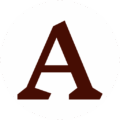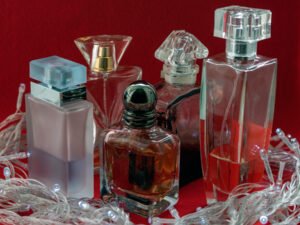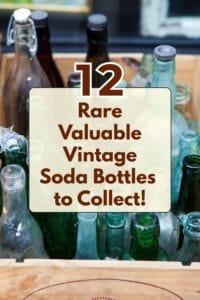Believe me on this, that dusty old milk bottle in your attic could be worth more than you think! Some vintage dairy bottles sell for hundreds or more, like the $500 Thatcher’s Dairy bottle or rare embossed bottles commanding serious collector cash at auctions.
In this guide, I will show you some super rare old milk bottles that are highly collectible today! You’ll learn the telltale signs, markings, and features to identify antique milk bottles and understand whether your bottle is worth the money or not!
10 Rare Vintage Milk Bottles Worth Finding Now!
From the unique baby face cream-top bottles to rare ACL bottles, here are the 10 rare and valuable antique milk bottles worth looking for!
1. Original Thatcher Wire Clamp Milk Bottle
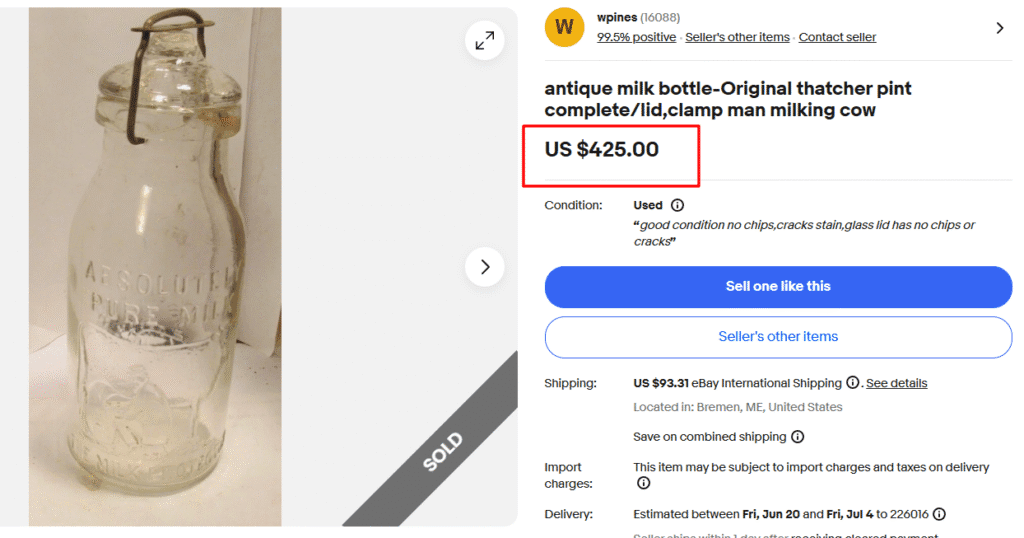
This is an original Thatcher milk bottle – one of the most historically significant pieces in vintage milk bottle collecting. What makes this bottle valuable is that this Thatcher milk bottle was patented by Dr. Hervey D. Thatcher in 1883, and it was one of the very first commercially successful glass milk containers ever produced.
You can spot it by Thatcher’s signature design element – embossed “ABSOLUTELY PURE MILK” text and the famous image of a man milking a cow. It also features a classic wire bail closure system with the original glass stopper lid!
Finding this bottle in excellent condition is pure luck! That’s why this charm was bought for $425 on eBay!
2. Rivera Dairy Baby Face Milk Bottle

The baby face milk bottles are one of the most popular ones! This one from Rivera Dairy bottle from Pueblo, Colorado, is a perfect example – and you can see why! The bulgy top of the bottle features a molded or embossed image of a baby’s face on the front!
This is a type of cream-top milk bottle that lets the cream sit on top of the milk before homogenization. For the Rivera Dairy branding and desirable design of this bottle, $400 is a fair price. The value can range from $300 to $800!
3. Antique Morro Bay Jersey Dairy Bottle
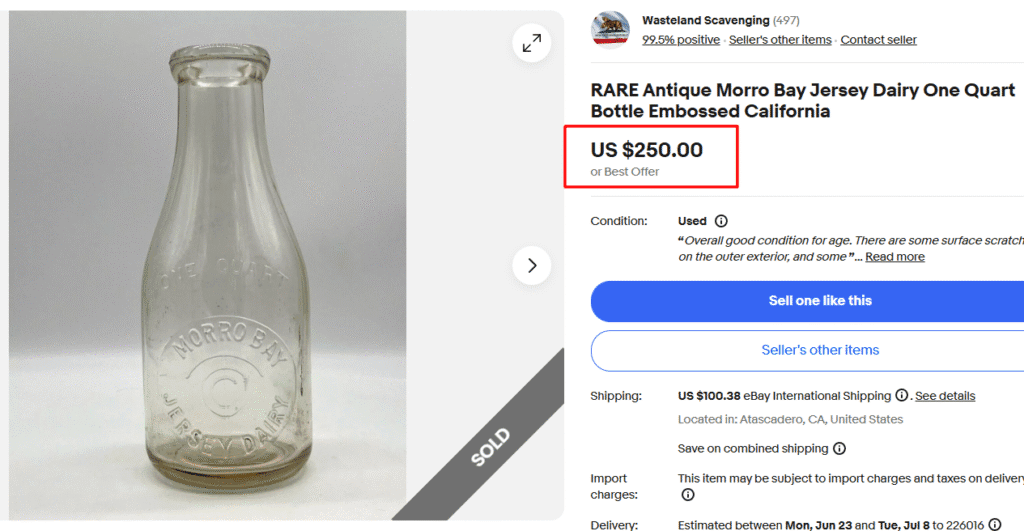
This beautiful embossed quart bottle is from Morro Bay Jersey Dairy, which was home to several dairies that took advantage of the area’s perfect climate for dairy farming. The clean embossed lettering and classic bottle shape make it antique and rare.
Such rare California dairy bottles are particularly sought after because many of the state’s small dairies were eventually absorbed by larger operations, making their bottles increasingly scarce.
4. WW2 Producers Dairy Victory Milk Bottle
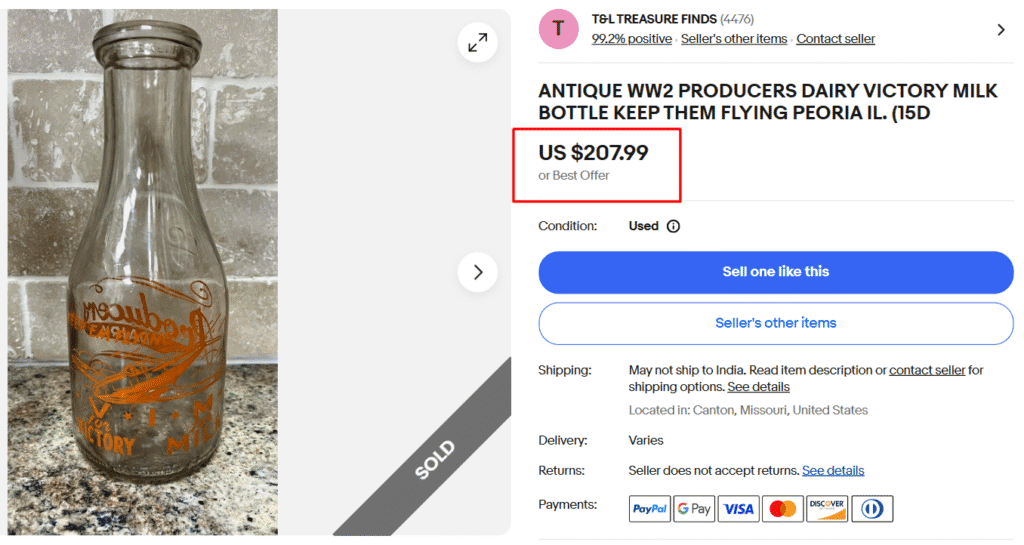
This bottle tells the wartime story. The “Keep Them Flying” slogan and victory theme clearly date this Producers Dairy bottle to World War II, when even milk bottles became part of the home front war effort.
The orange painted graphics on clear glass create a striking appearance that would have stood out on any kitchen table. “Victory Milk” wasn’t just a catchy name – it represented the dairy industry’s support to America during wartime, making this bottle historically significant and valuable!
WWII-era milk bottles with intact patriotic messaging are increasingly hard to find, making pieces like this highly sought after.
5. Vintage Babs Regional Milk Bottle

This clear glass milk bottle, made by the famous Owens-Illinois Glass Factory, is a collector’s charm. Owens-Illinois was one of the most important glass manufacturers in America, and their milk bottles are highly sought after by collectors.
The “Babs” designation referred to the Bab’s Drive in Dairy in Richmond, CA., for which the company made these bottles. Due to their limited production and regional significance, this bottle sold for a stunning price of $325!
6. Antique Milk Bottles With Porcelain Stoppers
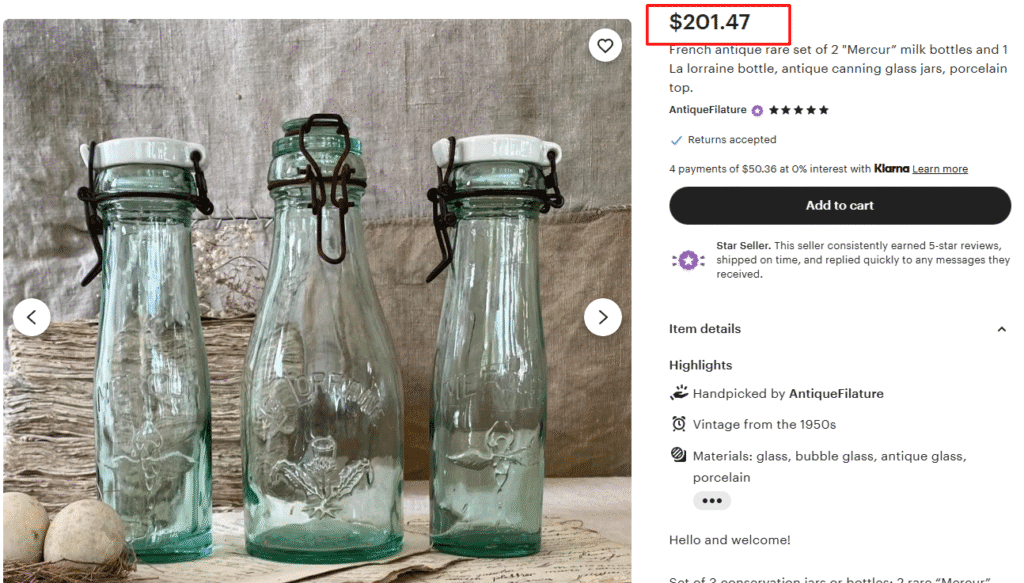
This set of two “Mercur” and one “La Lorraine” milk bottles has one thing in common: those distinctive wire bail closures and porcelain tops that were common in French dairies. These beautiful examples of French dairy packaging from the 1950s are rare finds today.
The green-tinted glass and bubble glass construction give these bottles a completely different aesthetic from American bottles. Single bottles in good condition can still fetch $40-$100.
7. Antique Borden’s Thick Glass Condensed Milk Jar

Another dairy utensil, which is not really a “bottle,” is a 1920s Borden’s condensed milk jar. It has a thick glass body with its embossed metal lid representing Borden’s, one of the most important names in the American dairy scene, innovative approach to milk packaging.
The ribbed glass design and substantial construction are signs of quality production by Borden. These jars, especially with the original metal lids (like this one), can be particularly valuable – most of these jars have lost their lids over the decades.
8. Horlick’s Malted Milk Jar
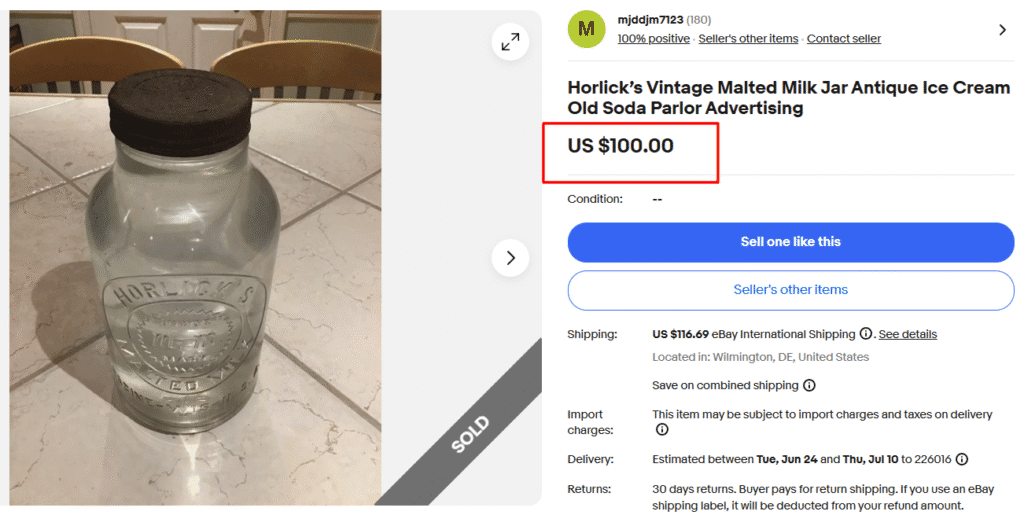
This isn’t technically a milk bottle, but it’s closely related to dairy – it’s a vintage Horlick’s Malted Milk jar. Horlick’s was a major brand in the malted milk industry, and these jars were common fixtures in ice cream parlors and soda fountains across America.
The jar typically shows a clear embossed lettering. These institutional-sized jars are becoming increasingly hard to find, especially in good condition, which justifies the $100 sale!
9. Hamilton Dairy Purple Hand-blown Glass Milk Bottle
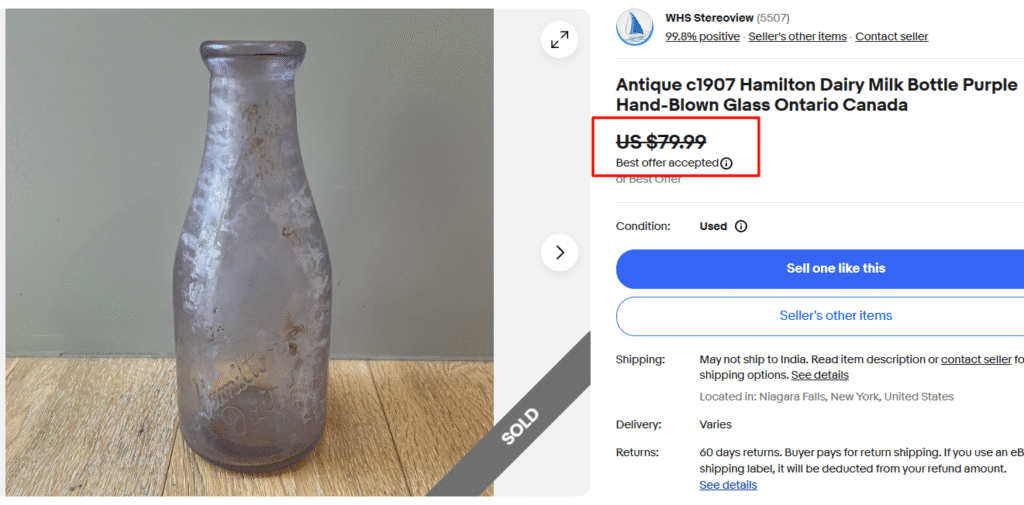
This gorgeous purple-tinted milk bottle from Hamilton Dairy in Ontario, Canada, is pure eye candy. Dating to around 1907, this hand-blown glass piece shows that distinctive amethyst color that happens when clear glass is exposed to sunlight over many decades – what collectors call “sun purple” or “desert glass.”
The bottle features embossed lettering identifying Hamilton Dairy. The purple coloration is even and beautiful, and you can still clearly read the dairy name. This type of early 20th-century milk bottle, especially one with such lovely color development, can easily fetch $50 to $200 or more.
10. Borden’s Elsie The Cow Quarter Milk Bottle

This is a set of two matching Borden’s square quart bottles featuring beloved Elsie the Cow. The bottles display Elsie in all her glory, complete with her signature flower necklace and that sweet, maternal expression that made her one of the most recognizable advertising mascots of the 20th century.
The red ACL painted labeling on clear glass is another valuable feature of this bottle. In excellent condition, these bottles can fetch $20-$30 (per bottle) and $40 to $80 for sets.
Created in 1936 during the Great Depression, Elsie was designed to make the Borden corporation seem more friendly and approachable. By the 1940s, she was so famous that 98% of Americans recognized her – more people knew Elsie than knew the President!
How to Identify Antique Milk Bottles Like a Pro (5 Key Signs)
To spot an authentic antique milk bottle, you need to know what signs to look for! From the types, designs, and closures, here are some key features to authenticate a dairy bottle:
Types of Milk Bottles
Many different milk bottles were made back in the day, with each one telling its own history, age, and makers.
- Round Bottles: These were your bread and butter – the go-to choice for most dairies. If you think “classic milk bottle,” this is probably what comes to mind.
- Square Bottles: These milk bottles started showing up more in the 1930s, and honestly, they were pretty smart. They packed better in trucks and fit more efficiently in those early refrigerators.
- Squat Bottles: They were the short, stocky cousins – wider and not as tall. Dairies often used these for cream or other specialty products that needed different handling.
- Cream Top Bottles: Before milk was homogenized, cream would naturally float to the top. These bottles had special necks – sometimes shaped like a little bowl – that made it easy to pour off just the cream. Some people called them “baby face” bottles because of their bulged shape.
- Specialty Bottles: These are unique bottles made by makers in unique shapes for buttermilk, whipping cream, or even chocolate milk. Each dairy wanted to stand out, so they’d come up with their own twist on the basic design.
Authentic Age Clues
Certain features are clear indicators of a really old antique milk bottle. Here’s a breakdown of these features:
- Pontil Mark: If you’ve got a really old hand-blown bottle (we’re talking pre-1870s), flip it over and look for a pontil mark (a scar left when the glassblower broke off the pontil rod) on the bottom. The rougher the mark, the older your bottle. No pontil mark at all? You’re looking at a machine-made bottle from the late 1800s or newer.
- Mold Seams: Pay attention! No seams anywhere means the bottle is completely hand-blown (super rare pre-1800s stuff). Seams that run from the bottom up to the shoulder or neck indicate early machine-made or semi-automatic (late 1800s to early 1900s), while seams that go all the way over the lip indicate the early 1900s onward make.
- Machine Scars on the Bottom: Flip that bottle over. See a rough, off-center circular mark? That’s an Owen’s suction scar from 1905-1920. A penny-sized round mark? That’s from a plunger machine, common in the 1920s.
- Shape Evolution: This one’s easy to remember: Round bottoms with tall sides = pre-1930. Square bottoms with short sides = post-1940.
- Glass Thickness: Old hand-blown bottles feel chunky and heavy in your hands, and the glass thickness isn’t always even because the techniques weren’t as refined. As machines took over, bottles got thinner and more uniform.
- Color: Most milk bottles are clear, but look for subtle tints. Early glass often has this faint aqua or bluish-green color because of sand impurities. Later, the impurities were removed for clearer glass. You may occasionally find amber or colored bottles, but those were usually for specialty products.
Bottle Closures

Closures are your biggest clue for dating a milk bottle because the makers changed the way they sealed these quite a bit over the years.
- Cork and Glass Stoppers: These were some of the earliest attempts at keeping milk fresh. You might find these on experimental milk jars where they’d use corks or glass stoppers held down with wire contraptions or metal clamps. The “Lester Milk Jar” is a good example, along with some of those early Thatcher designs.
- Cap Seats: Around 1900, the Thatcher Manufacturing Company came out with their “Common Sense” milk bottle, and it had this neat little recessed rim right below the lip. That groove was made to hold a cardboard disc cap – pretty clever, actually. After that, most milk bottles had cap seats.
- Wire Bails with Porcelain Stoppers: These were another advancement, especially for sterilized milk. These worked like those old-fashioned soda bottles or canning jars – with a wire mechanism that clamped down a porcelain or glass stopper. They were sturdy, but probably a pain to deal with.
Marking Types

Not all vintage milk bottles look the same. Here’s what you need to know about the main design types:
- Embossed Bottles (Pre-1933): These bottles have raised letters and designs molded right into the glass. You’ll see dairy names, cow images, and sometimes elaborate graphics. The text literally sticks out from the bottle surface.
- Applied Color Label Bottles (1933 and Later): After 1933, dairies started using colorful painted “Applied Color Label” or ACL labels, aka “pyroglaze” or “pyro.” These came in red, blue, black, and other colors. The graphics could get pretty fancy – think detailed farm scenes and eye-catching logos.
- War Slogan Bottles (1940s): When World War II hit, dairies went all-out patriotic. These bottles feature amazing graphics with slogans like “Buy War Bonds” and “Support Our Troops.” They’re some of the most sought-after bottles today.
- Character Bottles: Disney characters, Hopalong Cassidy, Borden’s Elsie the Cow – if it was popular, it probably ended up on a milk bottle. Kids loved them, and collectors pay top dollar for them now.
Expert Tip: Scratch the painted label with your fingernail. If it comes off, you’ve got a fake. Real applied color labels are fused into the glass and won’t scratch off.
Maker’s Marks & Branding
These are like signatures left by the glass companies that made these bottles. You’ll usually find them stamped on the bottom or sometimes on the heel – the curved part where the side meets the base.
These marks might be initials, little symbols, or even the full company name. Here’s the cool part: if you can figure out what company made your bottle, you can often pin down exactly when it was produced. Glass companies were pretty systematic about this stuff – they’d use specific marks during certain time periods and change them up as the years went on.
Take Owens-Illinois Glass Company, for example. They’d mark their bottles with an “O” that had an “I” inside it. Thatcher Manufacturing Company used “MTC.” Once you know what to look for, these marks become like a dating system for your bottle.
Dairy Branding
This is the biggest, most obvious marking you’ll see on a milk bottle. The dairy’s name, their city and state, and often some kind of logo or catchy slogan were all part of getting people to remember their brand.
For collectors, this is often what matters most. Some folks focus on bottles from their hometown, others chase after specific dairies that had particularly cool designs.
What’s really neat is watching how the branding evolved over time. Early bottles might just have the dairy name pressed right into the glass. Later on, you’d see fancy multi-colored designs painted on with ACL (Applied Color Labeling). The fancier the design, the more recent the bottle probably is.
What Makes Old Milk Bottles Valuable?
In case of old milk bottles, there are four key factors determining their overall value:
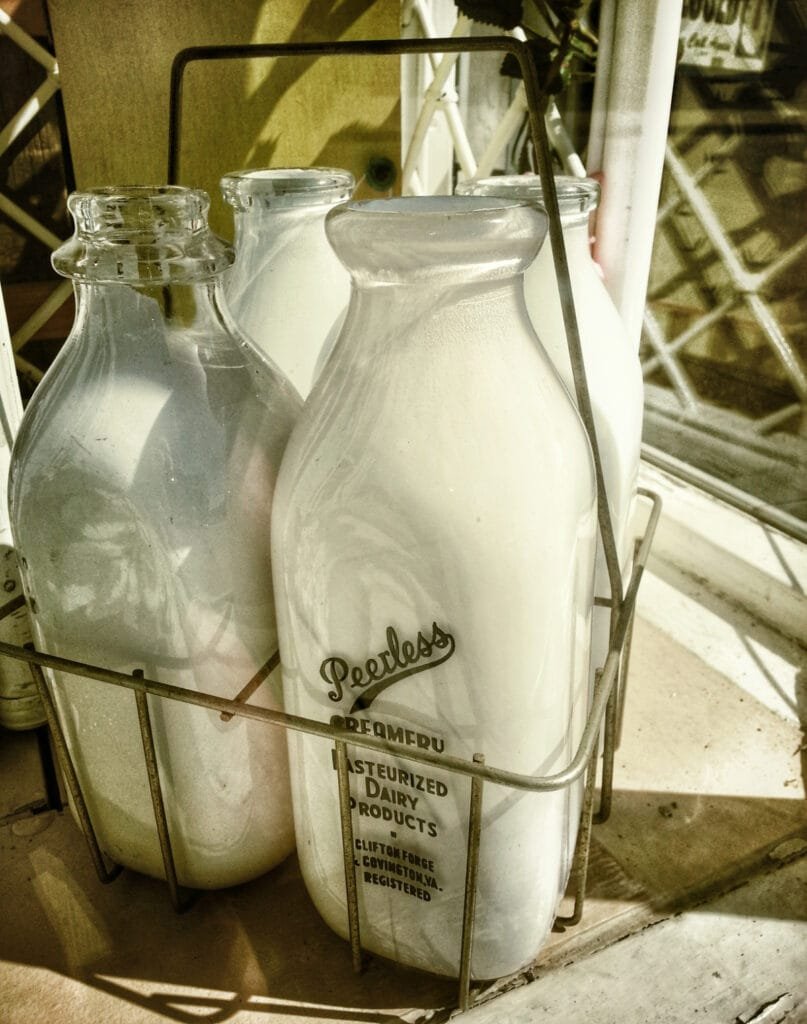
Age
Generally, the older the bottle, the better and more valuable. But collectors must understand that just because a bottle is old doesn’t automatically make it worth a fortune. Sure, age matters, but it’s not the whole story.
For instance, you could have a gorgeous ACL bottle from the 1950s with bright, perfect colors that’s worth way more than a beat-up embossed bottle from the 1890s. Condition and rarity often trump pure age.
That said, the really authentic features, like bottles with pontil marks or those weird experimental closures, that’s what matters the most.
Condition
This is the most crucial factor influencing a bottle’s value. A perfect bottle will always beat a damaged one, no matter how rare it is. So, make sure to check for chips, cracks, or scratches; these are instant value killers. Also, label clarity, completeness (original caps or closures) also impact the value.
Rarity
Naturally, certain bottles are always worth more than others, for example, bottles made in a limited number or for a limited period by a renowned brand.
Here are some examples of rare milk bottles:
- Early bottles with domed glass lids and metal bails
- White or green milk glass bottles (not clear glass)
- Thatcher bottles with the cow-and-farmer embossing
- War slogan bottles with detailed graphics
- Disney character bottles
- Bottles with manufacturing errors, unique mold variations, or distinctive designs
In addition, old milk bottles from small, short-lived dairies are collectors’ gold. Why? They didn’t make many, and fewer survived. A bottle from “Joe’s Farm Dairy” in rural Kansas might be worth more than one from a big city operation.
Size & Shape
Although not significantly, the size of a bottle does somehow impact its value. Extra-large/tall bottles can fetch high values, especially if found in good condition. Similarly, bottles with shapes other than the regular round and square shapes, and antique closures are considered rare and valuable.
Note: This article is intended for informational, educational, and entertainment purposes only. Some images are illustrative and may not represent actual brands, products, or related entities. All trademarks, product names, brand logos, packaging, and other intellectual property referenced remain the exclusive property of their respective owners. Any brand mentions or references are provided solely for descriptive and educational context and do not imply any formal or commercial association.


